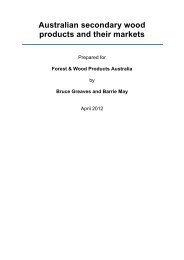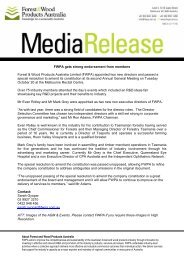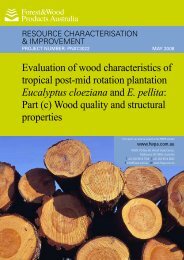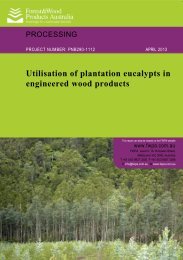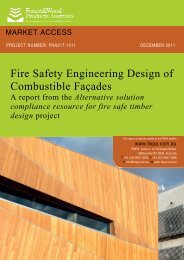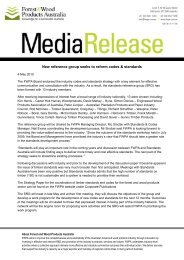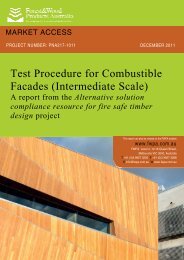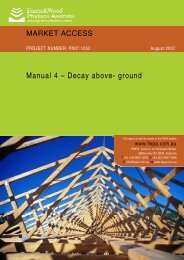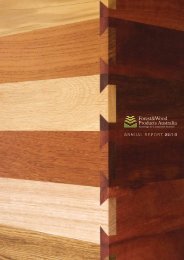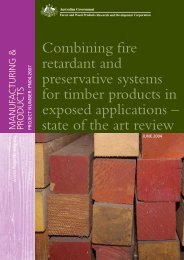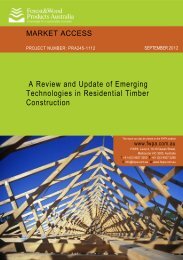Water-use efficient plantations - Forest and Wood Products Australia
Water-use efficient plantations - Forest and Wood Products Australia
Water-use efficient plantations - Forest and Wood Products Australia
Create successful ePaper yourself
Turn your PDF publications into a flip-book with our unique Google optimized e-Paper software.
3.3 Observed variation in the water-<strong>use</strong> efficiency of wood production<br />
3.3.1 Overall patterns<br />
When data for most sites, treatments <strong>and</strong> measurement years were aggregated there was a<br />
weak positive correlation between current annual increment (CAI) <strong>and</strong> annual<br />
evapotranspiration 1 (Figure 2). The current annual water-<strong>use</strong> efficiency of wood production<br />
Ww varied from less than 0.5 to 8.3 m 3 ML -1 , but except for plots with access to<br />
groundwater <strong>and</strong> one plot at Scott River with very shallow soil, Ww was between 1 <strong>and</strong> 5 m 3<br />
ML -1 .<br />
Current annual increment (m 3 ha -1 )<br />
70.00<br />
60.00<br />
50.00<br />
40.00<br />
30.00<br />
20.00<br />
10.00<br />
0.00<br />
0.00 200.00 400.00 600.00 800.00 1000.00 1200.00 1400.00 1600.00 1800.00<br />
Annual evapotranspiration (mm)<br />
Scott River<br />
Scott River +N<br />
Wellstead<br />
Esperance<br />
Hingston WA sites<br />
GT glob + WT<br />
GT Pine<br />
GT Pine + WT<br />
WUE = 5 m3 ML-1<br />
WUE = 3<br />
WUE = 1<br />
Figure 2. Current annual increment as a function of annual evapotranspiration for a range of<br />
species, regions, st<strong>and</strong> ages, thinning <strong>and</strong> fertiliser treatments including Scott River (with <strong>and</strong><br />
without N – all stocking densities included), Wellstead (only high N treatment shown – all stocking<br />
densities included), Esperance (both species included), Hingston <strong>and</strong> Galbraith’s (1998) WA sites<br />
<strong>and</strong> E. globulus <strong>and</strong> Pinus radiata in the Green Triangle. The lines show the trajectory of the<br />
relationship between CAI <strong>and</strong> Et for Ww of 1 (broken), 3 (dashed) <strong>and</strong> 5 (solid) m 3 ML -1<br />
The observed range of variation suggests scope for gains in Ww through improved<br />
plantation management. At rain-fed sites (no groundwater or irrigation) Ww peaked at<br />
around canopy closure <strong>and</strong> then decline with increasing st<strong>and</strong> age. A wide range of st<strong>and</strong><br />
ages are represented in this dataset <strong>and</strong> the period of measurement does not always overlap<br />
(Table 3) making it difficult to reliably compare sites. Figure 3 shows Ww for the fifth year<br />
of growth for sites <strong>and</strong> groups of sites where measurements were made at this age.<br />
Observations that warrant closer investigation include:<br />
• At Scott River Ww increased more than two fold in response to application of<br />
nitrogen. A smaller, but still significant, increase in Ww was observed in response to<br />
nitrogen at Boyup Brook.<br />
• In the thinning trials at Scott River <strong>and</strong> Wellstead there was a consistent but nonsignificant<br />
trend towards greater Ww with increased stocking density.<br />
1 -1<br />
Evapotranspiration is given both in mm rainfall equivalent <strong>and</strong> ML. Note that one ML ha equates<br />
to 100 mm.<br />
13



